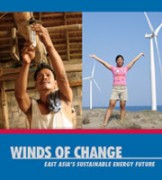19 April 2010: The World Bank has released a report titled “Winds of Change: East Asia’s Sustainable Energy Future,” which argues that the six major energy-using countries of East Asia could stabilize their greenhouse gas (GHG) emissions by 2025 without compromising growth.
According to the report, major investments in energy efficiency and a concerted switch […]
 19 April 2010: The World Bank has released a report titled “Winds of Change: East Asia’s Sustainable Energy Future,” which argues that the six major energy-using countries of East Asia could stabilize their greenhouse gas (GHG) emissions by 2025 without compromising growth.
19 April 2010: The World Bank has released a report titled “Winds of Change: East Asia’s Sustainable Energy Future,” which argues that the six major energy-using countries of East Asia could stabilize their greenhouse gas (GHG) emissions by 2025 without compromising growth.
According to the report, major investments in energy efficiency and a concerted switch to renewable sources of power in China, Indonesia, Malaysia, the Philippines, Thailand and Viet Nam could simultaneously stabilize GHG emissions, increase energy security and improve local environments. The report also underlines that a 10-fold increase in GDP in East Asia in the last three decades has led to a tripling of energy consumption. This consumption is expected to double again in the next two decades as the urban population increases by 50% and industrialization of the region continues.
In order to stabilize East Asia’s carbon dioxide emissions by 2025 without compromising economic growth, the study recommends that governments take immediate action to transform their energy sectors towards higher energy efficiency and more widespread use of low-carbon technologies. The study notes that while many East Asian countries are taking steps in this direction, accelerating the speed and scaling up the efforts are needed to get onto a sustainable energy path. It concludes that the window of opportunity is closing fast, because delaying action would lock the region into a long-lasting high-carbon infrastructure. [World Bank Press Release] [Executive Summary] [Full Report]